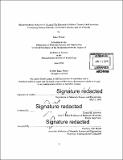Electrochemical behavior of a liquid tin electrode in molten ternary salt electrolyte containing sodium chloride, aluminum chloride, and tin chloride
Author(s)
Watari, Raku
DownloadFull printable version (3.748Mb)
Other Contributors
Massachusetts Institute of Technology. Department of Materials Science and Engineering.
Advisor
Donald R. Sadoway
Terms of use
Metadata
Show full item recordAbstract
One of the key limitations in the wide-scale adoption of mature renewable energy technologies is the lack of grid-level energy storage solutions. One important figure of merit in these battery systems is a high rate capability to match fluctuating demands for electricity. Molten salt batteries are an attractive option for stationary storage due to fast kinetics and good cycling capability, but high temperatures (>300 °C) limit available materials. In this thesis, the molten NaCl-AlCl3-SnCl2 electrolyte and liquid Sn electrode couple at 250 °C is investigated as part of the potential cell Na I NaCl-AlCl 3-SnCl2 I Sn for a lower temperature molten salt battery. An electrochemical study of the kinetics in the molten salt electrolyte and at the liquid Sn electrode-electrolyte interface is conducted using cyclic voltammetry and the galvanostatic pulse method. The liquid metal electrode is found to have suitably fast kinetics with an exchange current density of 92 mA/cm2. Parameters for a new Na+ conducting membrane are proposed, requiring an ionic conductivity of 0.056 S/cm, which would allow for a hypothetical Na I NaCl-AlC 3-SnCl2 I Sn battery to operate with an energy efficiency of 70%.
Description
Thesis: S.B., Massachusetts Institute of Technology, Department of Materials Science and Engineering, 2016. Cataloged from PDF version of thesis. Includes bibliographical references (pages 33-34).
Date issued
2016Department
Massachusetts Institute of Technology. Department of Materials Science and EngineeringPublisher
Massachusetts Institute of Technology
Keywords
Materials Science and Engineering.